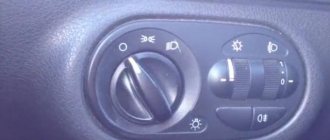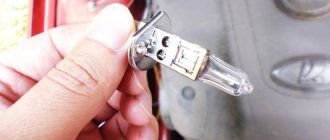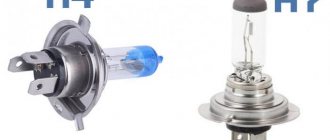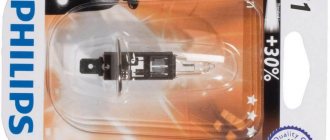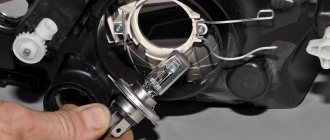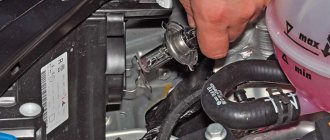If the low beam lamps on a car often burn out, it doesn’t matter whether one or all of them at the same time, then the first thing to do is measure the voltage in the on-board network.
This is not difficult to do - take a multimeter, set the measurement threshold to no more than 20 volts, start the car, connect the black wire of the device to the minus, and the red wire to the positive of the battery. The readings should not exceed 14.5V.
There is no point in taking readings directly on the lamp since they will still be less there (voltage loss on the connectors and in the wires).
If the voltage is higher than 14.5 volts, then the battery may be overcharged, keep this in mind.
What are lamps afraid of?
Any low or high beam lamps on a car will burn out prematurely if:
- Dirt got on them;
- You pawed them with your hands;
- You often drive on bad roads and the car constantly shakes;
- You close the hood with force, for example, throw it, and vibration is transmitted to the nearby lamps;
- Cold - at low temperatures, the resistance in the wiring decreases, which means the starting current increases, which is why the low beam lamp may burn out when starting the engine in severe frost (read the continuation of the topic below);
- Voltage drop and increased current.
What if the sensors feel strange or the needles are attached?
When sensors seem to move erratically or have the longest possible delay, the problem is usually a bad component, such as the device's voltage regulator or a bad ground.
Erratic gauges, or gauges that seem to read uniformly low, are usually caused by a bad tool voltage regulator. In some cases, you can remove the regulator, clean the connector terminals, and reinstall it.
Gauges that read completely all the time are usually caused by a weak or poor ground. If you can locate the ground, either visually or via an electrical diagram, you'll need to make sure it's secure and free of rust or corrosion.
Which lamps burn out more often?
There is no need to hope that expensive products from Philips burn out less often than from the Chinese “Mayak”; it happens, just the opposite.
Here the problem should be looked for not in the quality of the product or in the manufacturer, but in the operating features of the car’s electronics and its design. We should also not forget about a number of factors that affect the service life of lighting fixtures, but more about them below.
Low beam lamps located on the driver's left tend to burn out more often than those on the right.
This is due to the fact that the wires going from the switching unit to the headlights have different lengths, and, accordingly, different resistance (R).
From physics we know that the amount of current is inversely proportional to the amount of resistance.
That is, if a wire goes to the left headlight that is half as long as to the right one, and this is actually the case, then the starting current will flow to it twice as much, which reduces the service life of the device.
On most modern cars, the low beam headlights turn on automatically when the engine is started. At this time, the engine is just starting to pick up speed and does not work stably, the starter stops rotating and the generator starts working, and the battery begins to receive charging current.
All these switching modes negatively affect the operation of electronics, including lighting devices.
Therefore, if possible, and many cars have it, first start the engine, and after a while turn on the low beam headlights, or better yet, the running lights if they have them.
Also, in order to extend the “life” of the lamps, many craftsmen install special boards for smooth ignition of the low beam, solder in diodes, running light relays, but this is another story and a difficult solution for the average car enthusiast.
What to do when the sensors in your car don't work
The dashboard lights in your car tell a complex story about everything from your current speed, to the health and condition of your engine, and even whether things like your headlights are on. Different vehicles have different gauges, and some dashboards are much more complex than others. But when the sensors in your car stop working, you cannot ignore the situation.
When one sensor stops working, the problem may be the sensor itself or a bad sensor, while all the sensors going off at the same time often indicate a blown fuse or faulty instrument cluster.
The most common causes of sensor failure in a car can be broken down into three scenarios:
None of the sensors are working.
- If none of the sensors work at all, the problem may be a blown fuse or a faulty instrument cluster.
- If all the gauges are reading low or erratic, there may be a problem with the voltage regulator that powers the instrument cluster.
- If all the sensors are connected to the highest possible reading, it may be due to a wiring problem or a bad voltage regulator on the unit.
Interrelation of factors
The service life of all lamps, not just low beams, is influenced by a number of factors. We have already mentioned some of them above.
The table below shows the relationship between voltage, luminous efficiency and product life.
Here we see that 13.2V is taken as 100% - this is the voltage at which the ideal balance between service life and light output is achieved.
But then the following picture is observed - with an increase in voltage by 5% (to 13.86 volts), light transmission increases only by 18%, and the lamp service life drops by 40% (to 60). And with a reading of 14.15V, the light transmission will increase only by 2.5 - 3%, and the service life will decrease by another 18%, i.e. up to 42% of the declared one.
In other words, increased voltage, especially sudden surges, negatively affect the service life of products.
Chevrolet Lacetti
In the Chevrolet Lacetti, the dimensions and low beam lamps are located next to each other, so they heat each other up greatly. This design decision negatively affected the service life of the latter, and they often burn out.
A solution to the problem can be found in replacing the dimensions with diode analogues, which heat up less, or installing a special relay that would turn off the side lights when the low beams are on. If you have your own solution to the problem, write in the comments.
What to do if only one sensor is not working?
When one sensor stops working, the problem is with the sensor, wiring, or sending device. If you are comfortable finding and removing sending devices and sensors, you can diagnose this type of problem yourself. Otherwise, you will have to take it to a mechanic.
Using the coolant temperature sensor as an example, the diagnostic procedure involves locating and disabling the sending unit. When the ignition is on, the sensor should register as cold. If you connect the sender wire to ground, the sensor should switch to a "hot" reading.
If the sensor moves as expected, you may suspect a bad sending unit. If the sensor does not move when you ground the sensor wire, you may suspect a bad sensor. Similar tests can be performed on all sensors in your instrument cluster, although specific procedures may differ from one application to another.
Niva Chevrolet
Niva Chevrolet has factory Philips LongLife low beam lamps, if they are burnt out, then try to install the same ones, as a rule, they last a long time, according to reviews 60,000 mileage, but no less than six months for sure.
The reasons for their burnout are the same (see above).
Many Niva Chevrolet car owners install xenon 5000 kelvin instead of burnt-out low beam lamps (lower is not reasonable), but it is important to install them correctly so as not to blind oncoming drivers. It is important to pay attention to the condition of the ignition units.
As a last resort, it is better to install inexpensive Chinese analogues of the “Mayak” type, which is not so expensive if they are replaced frequently.
Is it possible to save money?
If you were unable to get away with a simple warning for not working low beams or other lighting devices, you have the opportunity to pay a fine that is half the amount required.
According to Art. 32.2 of the Code of Administrative Offenses, all of the above articles fall under the opportunity to save 50% if you manage to pay the fine within a twenty-day period from the date of the decision on an administrative offense.
Kalina
The problem of low beam lamps burning out also affected the Lada Kalina. For some time, German products from OSRAM were installed on the car, which served for a very long time and the drivers were happy about it. Over time, the situation changed, and the problem worsened.
In addition to the general reasons mentioned above, this car model also has other reasons:
- The generator relay is faulty - as a rule, it changes. You need to contact a specialist;
- There have been cases when, in severe frost, a car's generator briefly produced a voltage of more than 15 volts. This led to the low beam lamps burning out if they were turned on immediately after starting the engine. To prevent this from happening, the low beam must be turned on only after preliminary operation of a strong current consumer (interior heater, etc.). Those. started the car, turned on the heater, let it run at maximum for 30-60 seconds, and then turned on the low beam headlights.
If you have your own experience in solving this problem on Lada Kalina, write in the comments.
What if the dashboard warning lights don't work?
While many vehicles have gauges that show specific information about everything from charging system status to coolant temperature, some cars and trucks have warning lights.
These warning lights are designed to illuminate when the input from a transmitting device or sensor is outside the expected range. So instead of a needle telling you that the coolant temperature is 230 degrees Fahrenheit, a similar red warning light will flash in the red danger zone, letting you know that the coolant is hotter than it should be.
These and other lights, such as your check engine light and ABS light, are designed to turn on when you turn the ignition key to the on position, which is called the check light bulb. If one or more light sources do not light up, it usually means the bulbs are burnt out.
If none of your dashboard warning lights turn on, including the check engine light, it is usually a fuse or a ground issue. This type of problem is diagnosed in the same way as a sensor that isn't working, so you'll have to check for power at the appropriate fuse and make sure the instrument cluster ground is good. If these things check, then the problem is usually a bad sending device or wiring.
Renault Logan
Renault Logan cars of the first assembly were previously equipped with OSRAM H4 Ultra Life 60/55w low beam lamps, about which you can only hear positive reviews from car owners.
Owners of the latest assemblies complain that low beam lamps often burn out.
The main reasons are the same as mentioned above (voltage surges, problems with the relay generator, etc.).
But Renault Logan is characterized by another problem - oxidized or carbonated contacts in the block to which the light sources are connected. For this reason, in these places the resistance increases, and therefore the ambient temperature, which is why the lamps burn out.
Many owners of this model praise products with thick thread from NARVA, but this is not a panacea.
What kind of lamps do you install in Renault Logan headlights and how did you solve the problems with their frequent burnout? Write in the comments.
What should I do if the indicator and instrument panel do not work?
If your gauges are not working and your instrument panels and indicators are also not illuminated, this is a sign that there may be a problem with the ground. This assumes that you have already checked the sensor fuse and determined that it is in good working order.
If the instrument cluster is not properly grounded, you will typically find that the indicators and instrument lamp do not work or only work intermittently. You may be able to test the ground by looking under the dash with a flashlight, but in many cases you will have to actually remove the instrument cluster.
Ford Focus 2
The car has products with an H7 socket. The manufacturer can be either General Electric or Philips. The first has the article 17123, the second has 12972 PR.
Common causes of optics burnout for Ford Focus 2 in addition to those listed above:
- Problems with the generator relay;
- The absence of a back cover in the headlight will lead to increased humidity, oxidation of the terminals, increased resistance in the circuit, and, accordingly, the air temperature in the area of the lamps.
- Incomplete fastening of the headlight to the body means there is a play that should not exist;
- The rubber plugs in the headlights are damaged or missing;
- Bad contacts in the fuse box responsible for daylight.
Some owners of Ford Focus 2, who were tired of constantly changing low beam lamps, approached the problem creatively - they installed a daylight control controller.
Thanks to this, only the high beam lamps work in the incandescent mode (drivers do not use them often). They are used instead of running lights.
This solution has a number of advantages:
- The side lights do not light up;
- The resource of low beam lamps is saved.
It is also worth paying attention to the correct installation of optics on the Ford Focus 2. First, the lamp is installed in the headlight and only then the base is connected. This prevents hand contact with the glass bulb.
If you have your own experience in this matter, write in the comments.
How to choose the right LEDs for a car
Miser pays twice. This saying has a lot to do with trying to save money on LEDs. A high-quality LED lamp is never cheap: an LED will either be inexpensive or will work for a long time - but not at the same time!
If the manufacturer is unknown, either refuse to purchase such an LED, or study the lamp itself:
- there should be no traces of casting or stamping on plastic elements;
- there should be no play or visible gaps on the base;
- the lamp should not flicker during operation;
- In terms of brightness, the lamp should not differ much from analogues with the same voltage consumption, power and temperature of the light flux.
The current and voltage characteristics must exactly correspond to the markings. When installing multiple LEDs into one driver, consider the overall current consumption level.
Lada Priora
Lada Priora was also affected by this problem. The reasons are still the same, but there is something to add here:
- Poor contact in the cartridge - clean it;
- Increased charge voltage - take measurements (see at the beginning of the article).
- Poor quality of products - use original ones.
Solution:
- Installation of DRLs (daytime running lights);
- Many Lada Priora owners praise the OSRAM SilverStar 2.0, Osram 64210 ALL, Philips 12972 PRC1 or factory Mayak LBS, but there are so many people and so many opinions.
Great Wall Hover H5
If the model has a gasoline engine, then when reverse gear is engaged, voltage surges occur. This is not the case in cars with diesel engines.
This is easy to diagnose - put the car in reverse and see how much the headlights have dimmed. If it is strong, then there is a danger of lamps burning out.
The problem is solved by installing a special stabilizer, it consists of:
- Diode;
- Relay;
- fuse;
- Capacitor 5000 uF 25V.
But for many this will be problematic. If you have your own solution to the problem, write in the comments.
When the speedometer doesn't work
While all gauges can be either analog or digital, speedometers are unique in that they can have mechanical or electrical inputs. All other instrument panels are connected to sensors or sending devices via wires, while your speedometer may use either a speed sensor or a physical cable.
In vehicles that use cables, the speedometer is physically connected to the transmission through the cable. The cable is usually square at both ends or square at one end and slotted at the other. When the cable breaks, the sensor may not move at all, or it may jerk a little.





